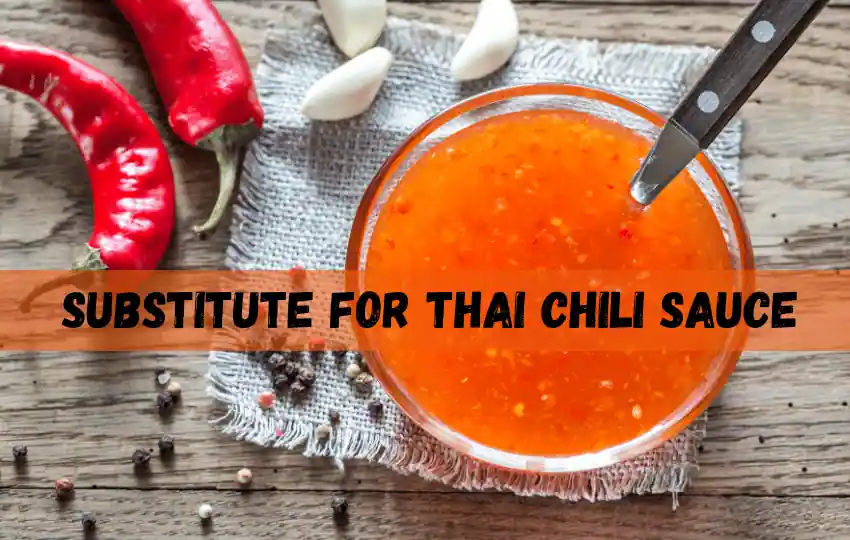Whether you are a lover of Thai cuisine, you know that chili sauce is a staple ingredient in many dishes. Thai cuisine is known for its bold, spicy flavors.
From the classic Tom Yum Goong to spicy papaya salad, Thai chili sauce is a staple ingredient that gives these dishes their distinct taste.
However, what if you don’t have any Thai chili sauce in your pantry, or what if you’re looking for a milder alternative?
Fear not, as there are plenty of quick and easy substitutes that you can use, all with varying levels of heat and flavor.
In this blog post, we’ll explore 13 of the best substitutes for Thai chili sauce, along with the ratios you should use and tips on how to incorporate them into your cooking.
In short, " What can I use instead of Thai chili sauce?" Sriracha, Sambal Oelek, Red Pepper Flakes, Tabasco Sauce, Harissa paste, Chili Garlic Sauce, Jalapeno Hot Sauce, Red Curry Paste, Sweet chili sauce, Cayenne Pepper, Hot Sauce, Chili Powder, Crushed Chili Peppers.
What is Thai chili sauce, and what does Thai chili sauce taste like?
Thai chili sauce is a condiment made from a blend of fresh red chilies, garlic, sugar, and fish sauce.
It has a sweet and spicy flavor with notes of tanginess from the fish sauce.
Depending on the recipe used to make it, Thai chili sauce can range from mild to very hot in terms of heat level.
The most popular way to use Thai chili sauce is as a dipping or marinade for dishes such as Pad Thai, fried rice noodles, spring rolls, chicken wings, salads, and soups.
When used as a marinade or dip, it adds an extra layer of flavor that cannot be achieved otherwise.
Thai chili sauce has become increasingly popular in recent years due to its versatility and ability to add an extra layer of flavor to many dishes.
Whether you are looking to add spice and heat or just some sweet and tangy flavors, Thai chili sauce is sure to be a hit!
Uses of Thai chili sauce
Thai chili sauce is a versatile condiment used to add flavor and spice to many dishes. It is applied as a dipping sauce for fried foods such as spring rolls or chicken wings or as a marinade for meats or seafood before grilling.
It also complements stir-fries, noodles, soup, and salads.
Thai chili sauce is frequently added to curries for an extra kick of heat, and it can be brushed onto grilled vegetables for an added layer of flavor.
Finally, this spicy condiment can even be used to top off some sweet desserts like fried bananas or ice cream sundaes.
When preparing Thai cuisine at home, Thai chili sauce should always have a spot on the kitchen shelf!
Learn more: Best bragg’s soy sauce alternatives & way to use
Best substitutes for Thai chili sauce with perfect measurement
1. Sriracha
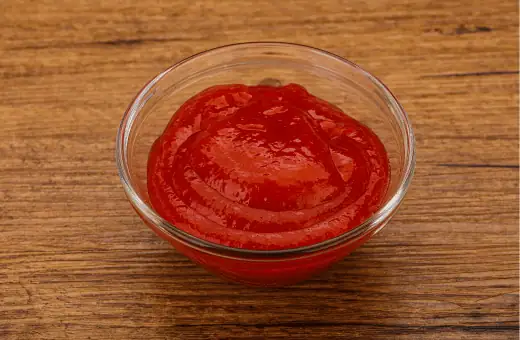
This iconic hot sauce is an excellent substitute for Thai chili sauce since it has a similar heat and flavor profile.
You can use the same amount of sriracha as you would Thai chili sauce in your recipes; just keep in mind that it can be slightly sweeter.
Ratio or measurement: Start with a 1:1 ratio, and adjust to taste.
It is readily available in most grocery stores.
2. Sambal Oelek
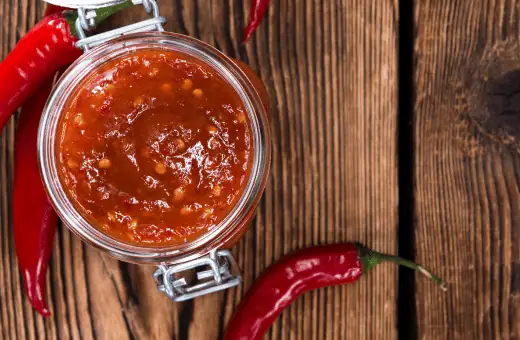
Made from ground chili peppers, Sambal Oelek is another fantastic substitute for Thai chili sauce. It has a bit more spice than sriracha, so use it in small amounts at first.
Ratio or measurement: You can use a 1:1 ratio of Sambal Oelek to Thai chili sauce.
3. Red Pepper Flakes
If you’re in a pinch, you can use red pepper flakes instead of Thai chili sauce. They are less potent than most chili sauces, so you may need to use more to achieve the desired heat.
Ratio or measurement: Start with a 1/2 teaspoon of red chili flakes per tablespoon of Thai chili sauce and adjust to your liking.
4. Tabasco Sauce
This vinegar-based Tabasco Sauce has a tangy flavor and packs a punch.
If you use it as an alternative to Thai chili sauce, use half the amount called for since it’s significantly spicier.
Ratio or measurement: Use a 1:1 ratio and adjust to taste.
5. Harissa paste
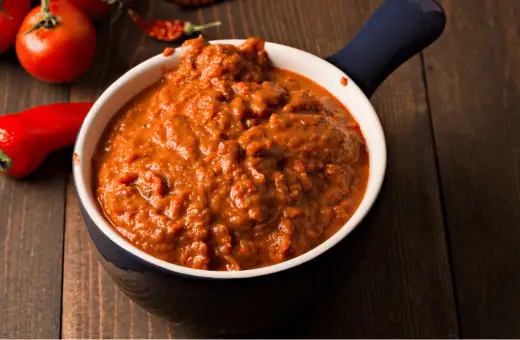
A North African chili paste made with roasted red peppers, garlic, and spices, Harissa paste, is a great substitute for Thai chili sauce.
It has a complex flavor like Thai chili sauce but with less heat.
Ratio or measurement: You can use a 1:1 ratio of Harissa to Thai chili sauce.
6. Chili Garlic Sauce
Made with garlic, red chili flakes, vinegar, and sugar, Chili Garlic Sauce can mirror the flavor of Thai chili sauce effectively.
Ratio or measurement: Use a 1:1 ratio in your recipes, but be aware it has a slightly sweeter taste than Thai chili sauce.
7. Jalapeno Hot Sauce
If you’re looking for a milder alternative to Thai chili sauce, Jalapeno Hot Sauce is an excellent option.
It has the same tangy flavor but with much less heat.
Ratio or measurement: You can use a 2:1 ratio of Jalapeno Hot Sauce to Thai chili sauce.
8. Red Curry Paste
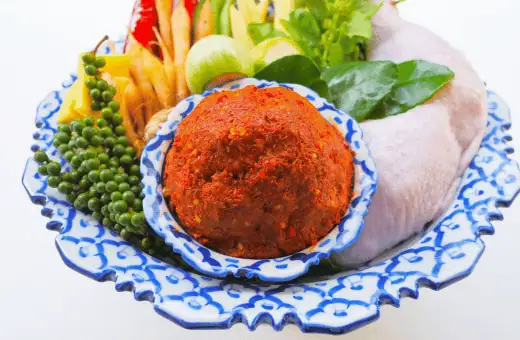
While not technically a hot sauce, red curry paste can add some of the same flavors to your dishes.
It has a combination of aromatics like lemongrass, garlic, and ginger, along with chilies.
It has a slightly different flavor than Thai chili sauce, but it works well as a substitute.
Use it in moderation and mix it with a little warm water to create a paste that can mimic the consistency of Thai chili sauce.
Ratio or measurement: Use a 1:1 ratio and adjust to taste.
9. Sweet chili sauce
Made from chilies, sugar, vinegar, and garlic, Sweet chili sauce is an excellent substitute for those who want a milder, sweeter flavor in their dishes.
Ratio or measurement: You can use it in a 1:1 ratio in your recipes, but be aware it's less spicy than Thai chili sauce.
10. Cayenne Pepper
Another easy substitute for Thai chili sauce, Cayenne pepper, is a spice that adds heat to your dishes without changing the flavor profile too much.
Use it sparingly since a little goes a long way.
Ratio or measurement: Start with a 1/4 teaspoon of cayenne per tablespoon of Thai chili sauce and go from there.
11. Hot Sauce

Hot sauce can be made from a variety of chili peppers, vinegar, and spices. Use your favorite hot sauce as a substitute for Thai chili sauce.
Ratio or measurement: Start with a 1:1 ratio and adjust to taste.
12. Chili Powder
Chili powder is a blend of spices, including chili peppers, cumin, and oregano.
Ratio or measurement: Use 1/2 to 1 teaspoon of chili powder per tablespoon of Thai chili sauce. Adjust to taste.
13. Crushed Chili Peppers
Crushed chili peppers are dried, crushed chili peppers that add heat to any dish.
Ratio or measurement: Use 1/4 to 1/2 teaspoon per tablespoon of Thai chili sauce.
Be cautious not to apply too much, as crushed chili peppers can be quite potent.
Discover more: Best Substitute for Marinara Sauce
Homemade Thai Chili sauce
Homemade Thai chili sauce is a popular condiment in Thai cuisine. It is a spicy and tangy sauce that is made using red chilies, garlic, vinegar, sugar, and salt.
The key to making a mouth-watering chili sauce is to balance the spiciness and the tanginess of the sauce.
To start making Thai chili sauce, you will need to gather all the ingredients. You can use any type of red chili, but Thai bird’s eye chili is the most commonly used chili in Thailand.
The chili has a spiciness level of around 50,000 to 100,000 on the Scoville scale. If you want a milder version of the sauce, you can use jalapeno chili instead.
The first step to making the sauce is to chop the chilies and garlic cloves into small pieces. You can use a food processor to do this, or you can slice them manually.
Be sure to wear gloves when you handle the chili, as it can cause a burning sensation on your skin.
Next, heat up a saucepan and add the chili and garlic mixture with some rice vinegar, sugar, and salt.
Rice vinegar is the preferred vinegar as it has a milder and sweeter taste compared to other vinegar.
The sugar will balance the spiciness and add a touch of sweetness to the sauce, while the salt will enhance the flavor.
Lower the heat to low and let the mixture simmer for about 15 to 20 minutes.
You will notice that the chili sauce will start to thicken, and the flavors will start to meld together. Take the pot off the heat and allow it to cool for about 10 minutes.
Once the Thai chili sauce has cooled down, pour it into a blender and blend it until it is smooth. You can modify the level of spiciness by applying more or less chili.
You can also adjust the sweetness by adding more or less sugar.
Finally, transfer the Thai chili sauce into a glass jar and store it in the fridge. Homemade Thai chili sauce can last for up to 2 to 3 months in the fridge.
You can use the sauce as a condiment for your favorite Thai dishes, as a marinade for meats, or as a dip for snacks.
In conclusion, making homemade Thai chili sauce is easy, cost-effective, and a great way to add some heat and flavor to your meals.
With just a few ingredients and simple steps, you can make a delicious and versatile condiment that will enhance any dish.
Where to buy Thai chili sauce?
There are some different places you can go. Many specialty food stores carry it, as do some international grocery stores.
You can also order online from many retailers that provide a variety of diverse flavors and types of Thai chili sauce.
Conclusion on substitute for Thai chili sauce
Now that you know the various substitutes for Thai chili sauce, you can try them out in your recipes and experiment to find out which ones work best for you.
Remember, start with a small amount and adjust as needed to achieve the desired level of heat and flavor. Don’t be afraid to get creative with combinations to create unique flavors in your cooking experiments.
With these quick and easy substitutes at your disposal, you’ll never be caught off guard when you’re out of Thai chili sauce again!
FAQs on substitute for Thai chili sauce
Q1. What is similar to Thai chili sauce?
Thai chili sauce is similar to other spicy sauces such as hot sauce, Sriracha, Sambal Oelek, and Gochujang.
It has a unique flavor profile because of the combination of ingredients like garlic, fish sauce, chilis, lime juice, and sugar that give it its distinct character. It can be used as a condiment and an ingredient in many dishes from Thailand and beyond.
Additionally, Thai chili sauce can also be used to add a kick of spice to marinades and dressings or even as a dip for various meats or vegetables. You can find different varieties available in most supermarkets or specialty Asian markets. Experiment with different types to find your favorite!
Q2. What is a Thai chili equivalent to?
The closest chili equivalent to Thai chilis is likely a bird’s eye chili. Bird’s eye chilis are also known as Thai chilis, and they are small peppers that pack quite a punch. They are usually red or green in color and range from mild to very hot on the Scoville scale.
They have a slightly fruity flavor with notes of citrus, although their intense heat can be overwhelming for some. Like Thai chilis, bird’s eye chilis are used in many Southeast Asian cuisines, particularly Thai and Vietnamese dishes.
These include curries, stir-fries, soups, noodles dishes and more.
If you can’t find Thai chilis, bird’s eye chilis make a great substitute. However, bear in mind that they are spicier than Thai chilis, and you may need to use less of them when cooking.
Q3. Is sriracha the same as Thai chili sauce?
No, sriracha is not the same as Thai chili sauce. Sriracha is a type of hot sauce made from chili peppers, vinegar, garlic, sugar and salt. It originated in Thailand but has become popular around the world for its distinctive flavor.
Thai chili sauce is a blend of sweet, sour and spicy flavors that may include chili peppers, vinegar, soy sauce, fish sauce and lime juice. Both sauces can add great flavor to dishes, but they are very different in terms of taste and ingredients. So while they can both be used to spice up food, they shouldn’t be thought of as interchangeable.
Q4. What can I use instead of Thai sriracha?
If you can’t find or don’t want to use Thai sriracha, there are a few other options that will provide similar levels of heat and flavor. You can try using other types of hot sauce like Tabasco or Frank’s Red Hot, as well as chili garlic paste or sambal oelek.
You can also make your own spicy condiment by combining ingredients such as garlic, chilies, sugar, vinegar and salt. If you’re looking for something less spicy but still flavorful, try adding some freshly diced jalapeños or a teaspoon of red pepper flakes to your dishes.
With a small creativity and experimentation, you can easily create an alternative to Thai sriracha that fits your taste preferences.
Q5. What is the difference between sriracha and sriracha chili sauce?
Sriracha and sriracha chili sauce are two different products, often confused as being the same. Sriracha is a type of Thai hot sauce that typically includes garlic, vinegar, salt, sugar, and chili peppers.
It is often served as a condiment alongside dishes such as noodles or rice. Sriracha chili sauce is an Americanized version of Sriracha that has been adapted to suit different tastes. The main dissimilarity between the two sauces is that sriracha chili sauce contains additional ingredients like tomato paste and other seasonings.
As a result, it tends to be milder in flavor than traditional sriracha. Additionally, many people also find that the texture of sriracha chili sauce is thicker and more spreadable than traditional sriracha sauce. Ultimately, both sauces can be used to add flavor and heat to dishes, but they should not be confused with the same product.

